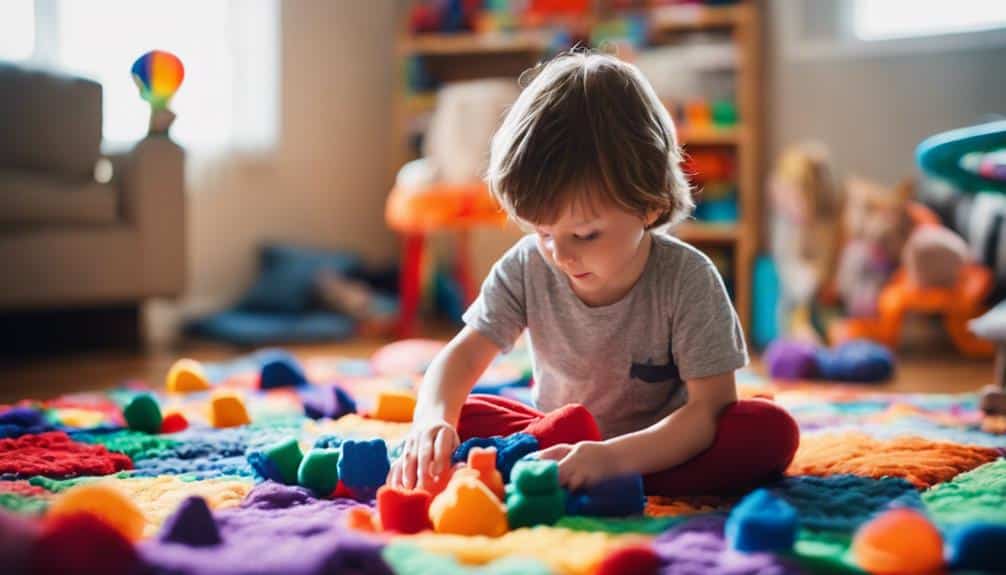In helping kids with autism, the best Sensory Integration Therapies are like superheroes making a big difference in their everyday lives. Three particular interventions—sensory boards, sensory table activities, and changes to the environment—stand out because they work well and can be adjusted to fit each child. Each way helps kids improve their fine motor skills, explore their senses, and create a peaceful space to focus and grow.
Even though people know these therapies are fantastic, there’s still much to learn about how to make them work best for each kid. That’s why it’s essential to look at how they work and determine the best ways to use them for each child’s needs.
Key Takeaways
- Sensory boards and table activities enhance fine motor skills and sensory exploration.
- Occupational therapy techniques like swinging and brushing directly address sensory challenges.
- Play-based interventions promote sensory integration in a fun, engaging manner.
- Music and sound therapy improve communication, emotional regulation, and sensory sensitivities.
Pediatric Occupational Therapy Techniques
Pediatric occupational therapy techniques, a cornerstone in sensory integration therapy, offer valuable tools to assist autistic children in navigating their sensory world more effectively. These methodologies are designed with a profound understanding of sensory processing issues that often accompany autism. By engaging autistic kids in structured, purposeful activities like swinging, brushing, and playing in ball pits, therapists address sensory challenges directly.
These activities are not merely play but carefully chosen sensory-based interventions to lower a child’s reactivity to sensory stimuli, enhancing their daily functioning.
The essence of occupational therapy in sensory integration therapy lies in its ability to tailor interventions to the unique needs of each child. This personalized approach ensures sensory activities reduce anxiety, improve behavior, and promote positive engagement in daily tasks. Occupational therapists are skilled in identifying the specific sensory inputs that a child might find overstimulating or understimulating and use this knowledge to create a therapeutic environment that encourages sensory learning and adaptation.
Play-Based Interventions
Building on the foundational techniques of occupational therapy, play-based interventions offer a dynamic and engaging pathway for autistic children to enhance their sensory processing skills. These interventions harness children’s natural inclination towards play, transforming therapeutic sessions into enjoyable and meaningful activities. By incorporating elements such as swinging, jumping, and brushing, play-based therapies facilitate sensory integration in a manner that feels less like therapy and more like playtime to the child.
The core benefits of play-based sensory integration therapies include:
- Enhanced Sensory Processing: Activities like swinging and jumping help autistic kids regulate sensory input, improving their ability to process information from their environment.
- Promotion of Sensory Exploration: Using tools such as therapy balls, sensory bins, and sensory boards encourages children to explore and interact with various textures, weights, and movements.
- Tailored Therapeutic Approach: Interventions are customized to each child’s unique sensory needs and preferences, ensuring optimal engagement and effectiveness.
- Increased Motivation and Participation: The playful nature of these interventions boosts motivation, participation, and, ultimately, positive outcomes in sensory processing capabilities.
Music and Sound Therapy

Harnessing the power of music and sound, therapy sessions designed for autistic children can significantly enhance their sensory processing, communication abilities, and emotional well-being. Music therapy and sound therapy are two interventions that have shown promising results in supporting autistic individuals, addressing a range of needs, from sensory sensitivities to fostering better social interactions.
| Therapy Type | Benefits for Autistic Children |
|---|---|
| Music Therapy | Enhances communication skills, emotional regulation, and social interactions. |
| Sound Therapy | Aids in sensory integration through specific frequencies, promoting relaxation and reducing anxiety. |
Research highlights that music therapy assists in developing communication skills and plays a crucial role in emotional regulation, making it an invaluable tool for children with autism. Similarly, sound therapy, focusing on specific frequencies and rhythms, contributes significantly to sensory integration, helping children manage their sensory sensitivities more effectively.
Incorporating these therapies into a child’s routine can lead to noticeable improvements in sensory modulation and attention, highlighting the profound impact that music and sound activities can have on sensory integration therapy outcomes. Parents and caregivers seeking to support their autistic children’s development will find these therapies practical and beneficial in fostering a sense of calm, improving communication, and enhancing overall emotional well-being.
Frequently Asked Questions
What Are the Sensory Integration Techniques for Autism?
Sensory integration techniques for autism involve therapeutic activities such as swinging, brushing, and engaging in ball pit play. These methods aim to enhance sensory processing, aiding children in regulating their responses to various stimuli.
What Are Sensory-Based Therapies for Autism?
Sensory-based therapies for autism are designed to help individuals manage and interpret sensory input more effectively, utilizing techniques such as brushing, swinging, and jumping to improve sensory integration and daily functioning.
Which Therapy Best Sensory Integration Therapies for Autistic Children?
The most effective therapy for autistic children varies, but Sensory Integration Therapy (SIT) significantly stands out. It focuses on enhancing sensory processing abilities through tailored play-based activities to improve daily functioning and emotional regulation.
What Are the Therapies for Sensory Integration?
How can we best support children facing sensory integration challenges? Therapies include occupational therapy, sensory diet activities, and auditory integration training, all aimed at enhancing sensory processing and promoting functional skills in a compassionate and understanding manner.
Conclusion
Autism Spectrum Disorder (ASD) is a developmental disorder associated with a range of sensory processing challenges, which can impact a child’s social skills, communication, and daily functions. Sensory-based interventions, including occupational therapy, have been shown to improve outcomes for children with ASD. A systematic review of studies published in the American Journal of Occupational Therapy found evidence of the efficacy of sensory integration therapies, including occupational therapy, for children with ASD.
Occupational therapists use a therapeutic approach that considers the sensory processing abilities of each child. Sensory input, such as vestibular and proprioceptive input, and sensory activities, such as using therapy balls and a ball pit, can help children with ASD develop body awareness, motor planning, and communication skills. Environmental modifications can also be made to reduce sensory overload.
Sensory processing deficits can lead to repetitive and self-stimulatory behaviors, affecting a child’s adaptive behaviors. Sensory-based interventions, including motor interventions, can help reduce these behaviors and promote positive behaviors. Speech therapy can also be used to improve communication skills.
In summary, a comprehensive approach for children with ASD should include sensory-based interventions, such as occupational therapy and speech therapy, physical activity, and sensory activities, to improve their sensory processing skills and develop their social, emotional, and academic skills. This integrative approach can help individuals with autism improve their quality of life in therapy sessions and daily lives.


Recent Comments